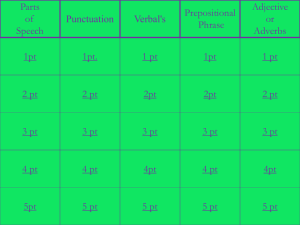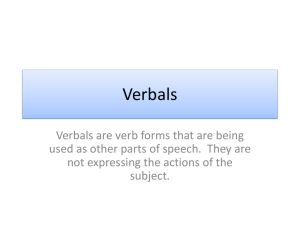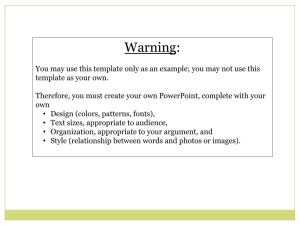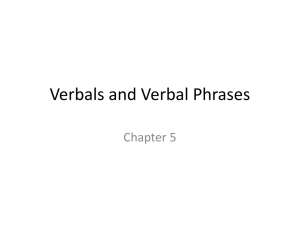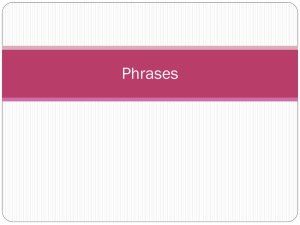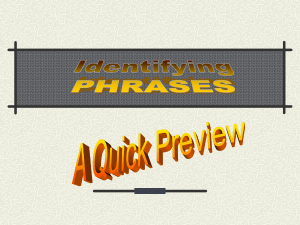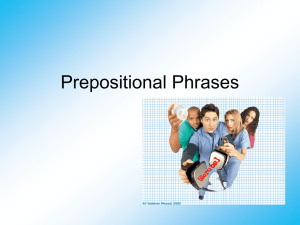File - Bobcat English II Pre-AP
advertisement
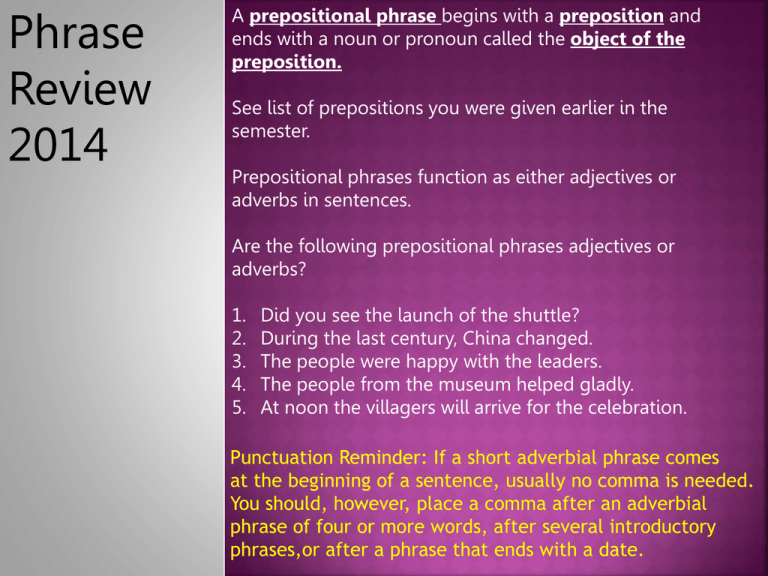
Phrase Review 2014 A prepositional phrase begins with a preposition and ends with a noun or pronoun called the object of the preposition. See list of prepositions you were given earlier in the semester. Prepositional phrases function as either adjectives or adverbs in sentences. Are the following prepositional phrases adjectives or adverbs? 1. 2. 3. 4. 5. Did you see the launch of the shuttle? During the last century, China changed. The people were happy with the leaders. The people from the museum helped gladly. At noon the villagers will arrive for the celebration. Punctuation Reminder: If a short adverbial phrase comes at the beginning of a sentence, usually no comma is needed. You should, however, place a comma after an adverbial phrase of four or more words, after several introductory phrases,or after a phrase that ends with a date. Phrase Review 2014 A appositive phrase is a noun or pronoun that identifies or explains another noun or pronoun next to it in a sentence along with its modifiers. Find the appositive and appositive phrases in each sentence and the word or words it modifies. 1. Lincoln’s first home, a log cabin in Kentucky, was located in Larue, Kentucky. 2. As the underdog in the 1858 senatorial campaign, Lincoln debated his opponent, Stephen Douglas. 3. Lincoln, a virtual unknown, was able to win the presidency in 1860. 4. Lincoln was assassinated by John Wilkes Booth, a radical, in April of 1865. Punctuation Reminder: If the information in an appositive is essential to the meaning of the sentence, no commas are needed. The information is usually essential if it names a specific person, place or thing. A comma is needed before and after an appositive phrase if the information is not essential to the meaning of the sentence. For EXAMPLE: The stage actor John Wilkes Booth shot Lincoln. John Wilkes Booth, the stage actor, shot Lincoln. Phrase Review 2014 A participial phrase is a participle (a verb form used as an adjective) with its modifiers and complements all working together as an ADJECTIVE. Present participles end in –ING. Past participles end in –ED. (There are exceptions!) Find the participial phrases in the following sentences and the nouns they modify. 1. Having studied for my geography test, I headed for school. 2. The test, given by Mr. Stephens, will be difficult. 3. Studying for the test, I learned many interesting facts. 4. Requiring heavy rainfall, tea does not grow well in dry regions. 5. Hungry sailors shipwrecked off the coast of Maine invented clam chowder. 6. I found a textbook packed with information for my test. Punctuation Reminder: Always place a comma after an introductory participial phrase. If the information in an internal phrase is essential, no commas are needed. Information is essential if it identifies a person, place, or thing. For EXAMPLE: The person talking to the teacher is my dad. Pete Jons, talking to the teacher, is my friend. Phrase Review 2014 A gerund phrase is a gerund (verb form that is used as a noun) with its modifiers and complements all working together as a NOUN. Gerunds ALWAYS end in ING. Underline the gerund phrases in the following sentences and write its function (as a noun). Noun functions are subject, direct object, indirect object, predicate nominative, object of the preposition, appositive. 1. 2. 3. 4. 5. 6. 7. My sister and I share an unusual interest, studying insects. She has learned many things by observing ants. I enjoyed accompanying her on her nature walks. My job is bringing along cameras and recording devices. We both like learning all about insects. A flea is capable of jumping thirteen inches in one leap. Lifting things ten times their own weight is no problem for some ants. Punctuation Reminder: Notice that because GERUNDS ONLY FUNCTION AS NOUNS, they are punctuated the same way any noun would be. Phrase Review 2014 An infinitive phrase is an infinitive (an infinitive begins with the word to) with its modifiers and complements all working together as a noun, adjective or an adverb. Because an infinitive begins with the word to, it is sometimes confused with a prepositional phrase. The infinitive is to followed by a verb, the prepositional phrase is to followed by a noun. Keep in mind that occasionally the word to in an infinitive is omitted (or understood) in the sentence. Underline the infinitive phrases in the following sentences and write whether it is used as a noun, adverb, or adjective. If it’s a noun, write its function. 1. As an actor, Bob had to learn many lines. 2. It took him about three weeks to memorize his part. 3. Actors seem to prefer the company of other actors. 4. We did not dare interrupt him. 5. Directors are known to demand long hours from casts. 6. From the middle of the balcony, we were unable to hear the actors. 7. To project his voice, an actor learns to breathe differently. Punctuation Reminder: Because infinitives act as adverbs and adjectives, if they are introductory, they should be followed commas. Phrase Review 2014 Misplaced and Dangling Modifiers A phrase that is used as an ADJECTIVE or ADVERB (modifier) should be placed as closely as possible to the word it modifies. A modifier that is placed too far away from the noun it modifies is a MISPLACED modifier. For example - Rick saw two owls camping on Camp Greylock. A modifier that is used but does not describe any word in the SENTENCE is a DANGLING modifier. For example - Hurrying from store to store, it was easy to lose track of time. If a sentence contains a Misplaced Modifier, write MM. If it contains a dangling modifier, label it DM. If the sentence is correct label it C. 1. We saw a graceful willow tree strolling around the lake. 2. Sailing into the harbor, we had our first glimpse of the campground. 3. That’s my mother’s camper parked at the dock with the red upholstery.



